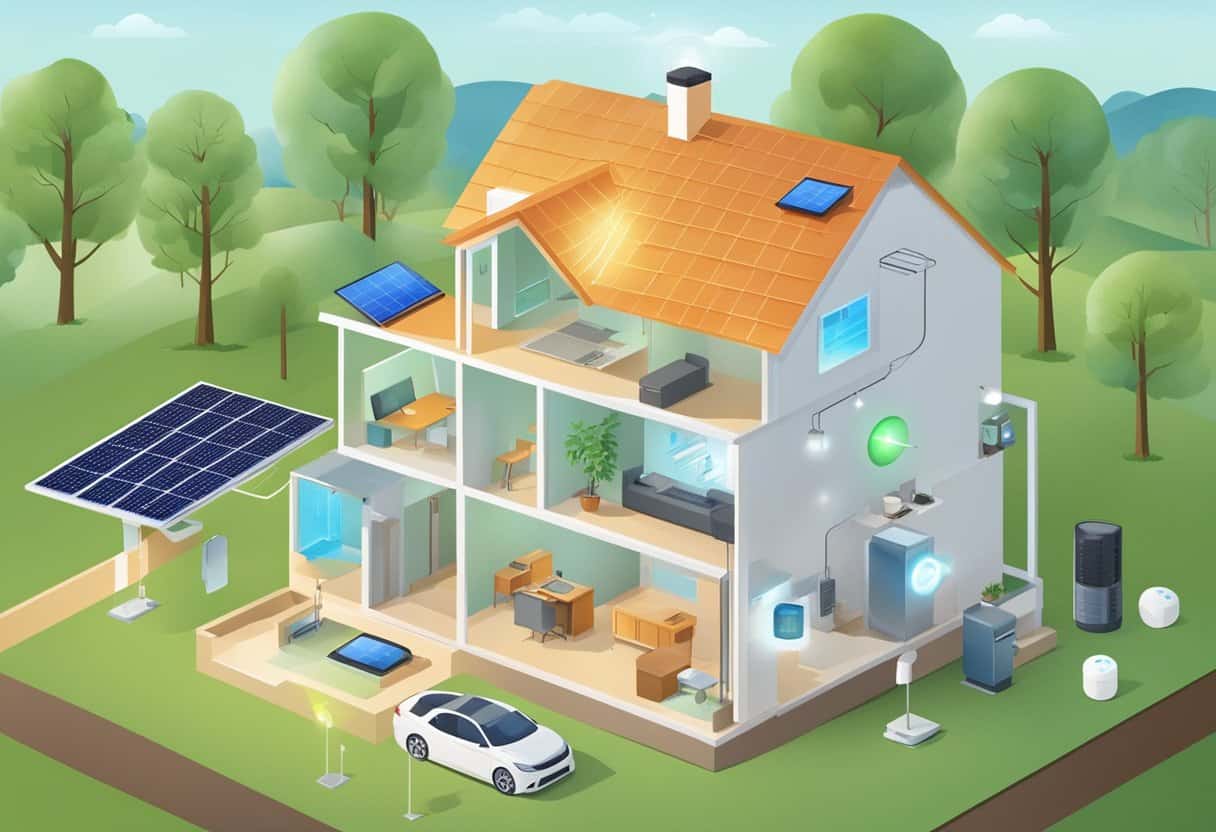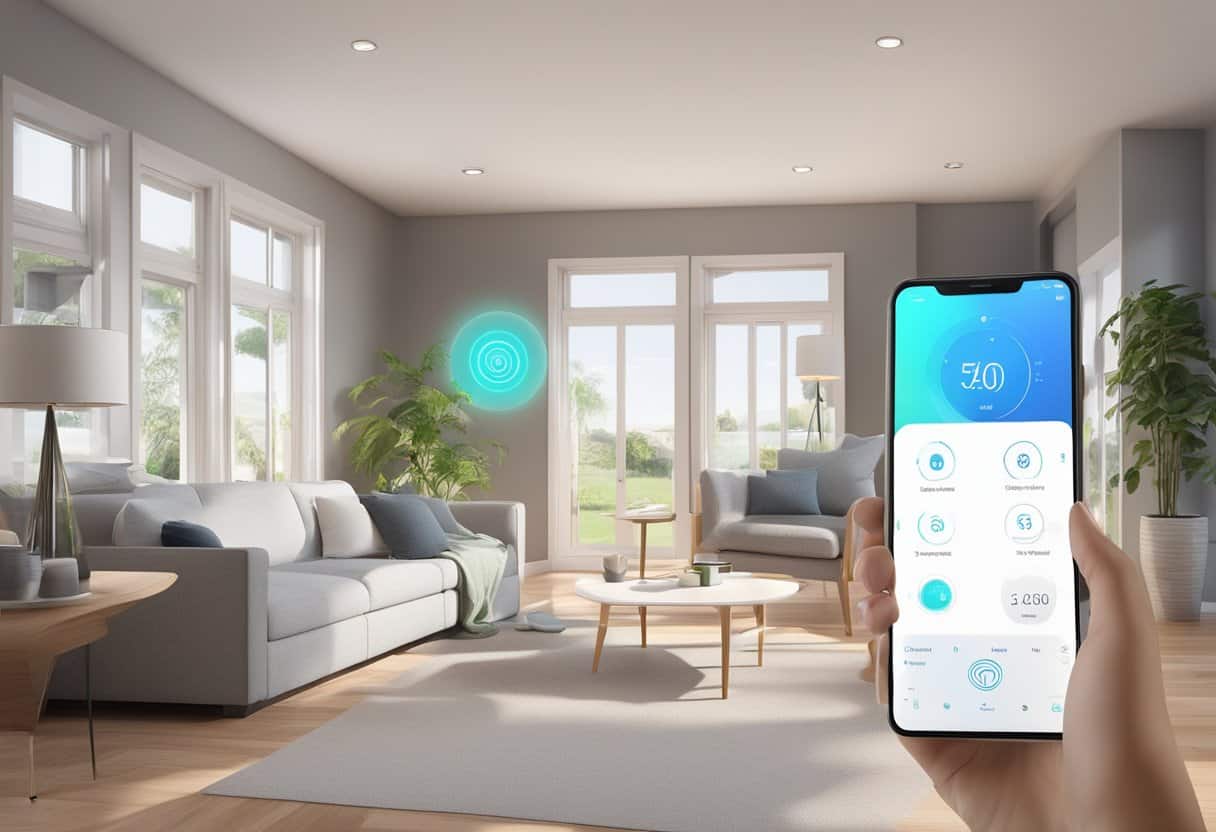Smart homes are no longer a glimpse into the future but are increasingly becoming part of the present, combining comfort, energy efficiency, and security through innovative technology. At the heart of these smart home systems are sensors – a network of hardware that collaborates to automate and optimize household functions. By understanding the different types of smart home sensors, you can better appreciate their functionalities and the advantages they bring to your living space.
Each sensor type in a smart home environment serves a unique purpose. For instance, motion sensors contribute to security and energy savings by detecting movement and automating lighting. Temperature sensors help maintain comfort by adjusting the heating or cooling systems based on the readings they collect. Additionally, sensors such as water leak detectors can prevent property damage by alerting you to early signs of leaks, potentially saving you from expensive repairs. By integrating these sensors, your smart home becomes not just a residence but a dynamic ecosystem that responds and adapts to your needs.
Smart homes use various sensors to automate tasks, improve security, and enhance comfort. Motion sensors detect movement for security or lighting automation. Temperature sensors maintain comfortable temperatures. Water leak detectors prevent damage. Smart home systems integrate these sensors for a dynamic and responsive living space.
Understanding Smart Home Sensors
Smart home sensors are pivotal in turning your house into a smart home. They provide real-time data and interfaces for automated systems, enhancing your ability to manage and interact with your home environment efficiently.
Core Functions and Types
Smart home sensors serve a multitude of functions, from monitoring environmental conditions to enhancing security. Environmental sensors measure parameters like temperature, humidity, and light, often found in products like Nest’s thermostats. Security sensors, including motion detectors and door/window sensors, are integral to systems like SmartThings or Amazon’s Alexa-supported ecosystems. Leak sensors alert you to water issues, and smoke detectors provide early fire warnings, essential for safety. The variety of types of sensors integrate seamlessly into smart home networks, offering you peace of mind and automated home management.
- Temperature Sensors
- Humidity Sensors
- Motion Sensors
- Contact Sensors (for windows and doors)
- Leak Detectors
- Smoke and Carbon Monoxide Detectors
Compatibility and Communication Protocols
When incorporating smart sensors into your home, compatibility is key. Most modern sensors communicate using standard communication protocols such as Zigbee, Z-Wave, Wi-Fi, or Bluetooth. It’s essential that the sensors you choose are compatible with your smart home hub/bridge, such as Apple Home, SmartThings, or Nest systems. Interoperability enables different devices and systems to work together flawlessly.
Protocol Compatibility Table:
| Sensor | Amazon Alexa | Apple HomeKit | Google Home | SmartThings |
|---|---|---|---|---|
| Zigbee | ☑ | ☐ | ☑ | ☑ |
| Z-Wave | ☑ | ☐ | ☑ | ☑ |
| Wi-Fi | ☑ | ☑ | ☑ | ☐ |
| Bluetooth | ☑ | ☑ | ☑ | ☐ |
The table represents whether the sensor type is typically compatible with the listed smart home platforms.
For seamless interaction, ensure your devices follow the same protocol or that your smart home system supports multiple protocols. This consideration will save you from the frustration of purchasing incompatible devices and help maintain a unified smart home system.
Sensor Categories and Specifics
When you integrate smart home technology into your life, choosing the right sensors is crucial for security, comfort, and efficiency. Each sensor type plays a specific role to enhance your home’s functionality.
Security and Safety Sensors
For security, motion sensors are essential. They detect movement, making them your first line of defense against intruders. Door sensors and window sensors alert you when these entry points are accessed without authorization. For safety, smoke detectors and carbon monoxide detectors provide early warnings of dangerous conditions, while water leak sensors help prevent costly damage.
- Motion Sensor: Detects movement using PIR technology.
- Security Alarm: Triggers an alert in case of unauthorized access.
- Smoke and Carbon Monoxide Detectors: Warns of smoke or harmful gases.
Environmental and Comfort Sensors
Your comfort is maintained by sensors that monitor and regulate air quality and temperature. Smart thermostats automatically adjust the temperature based on your preferences. Humidity sensors protect against excess moisture, and air quality sensors ensure a healthy atmosphere by tracking pollutants and allergens.
- Air Quality Sensor: Tracks pollutants for healthier indoor air.
- Temperature Sensor: Monitors and adjusts room temperature.
- Humidity Sensor: Maintains optimal moisture levels for comfort.
Utility and Efficiency Sensors
To enhance utility and efficiency, sensors monitor energy and water usage—helping you to save on your bills and reduce your environmental impact. Smart thermostats and light sensors optimize your home’s heating and lighting. Devices like gas leak sensors and energy consumption monitors offer insights into your utility usage, allowing for smarter and safer management.
- Water Leak Sensor: Alerts you to the presence of leaks.
- Smart Thermostat: Optimizes heating and cooling for energy efficiency.
- Vibration Sensors: Can indicate the functioning status of appliances and detect anomalies.
Selecting the appropriate sensor types for your smart home setup will ensure you are aware, comfortable, and efficient in your living space.
Sensor Technology and Power

When it comes to smart home sensors, understanding the types of technologies they use and how they are powered is crucial for selecting the right devices to meet your needs. These sensors can range in functionality, from detecting movement to monitoring air quality, and each type requires an appropriate power source to operate effectively.
Sensor Technologies
Smart home sensors employ a variety of technologies to perform their tasks. Ultrasonic sensors measure the distance to an object by using sound waves, which is particularly useful for presence detection. On the other hand, UV sensors are capable of detecting the level of ultraviolet light, helping you protect your home from harmful sun exposure. For environmental quality, sensors that identify pollutants, dust, pollen, and other particulates are available. These can alert you to poor air quality, allowing you to take action to improve your home’s atmosphere.
Most sensors are designed for quick setup and can either be stand-alone smart sensors that perform a specific function or multipurpose smart sensors such as the Aeotec Multisensor 7, which combines various sensing capabilities into a single device. The latter can provide excellent value and efficiency for your smart home ecosystem.
Power Sources and Battery Life
The power source of your smart home sensors is a determining factor in their installation flexibility and maintenance. Many sensors are powered by AA batteries, offering the convenience of battery life that can last up to a year or more depending on the sensor’s usage. This means you can place them almost anywhere without worrying about running cables.
Stand-alone smart sensors typically have longer battery lives due to their single functionality, while multipurpose sensors may require more frequent battery changes because they perform multiple tasks and thus consume more power. Sensor triggers and detecting capabilities influence energy usage as well; sensors that frequently activate will deplete their power source faster than those with less frequent triggers. Always consider the range of the sensor and the power source when planning your smart home setup to ensure optimal performance and minimal maintenance.
Smart Sensor Applications and Integration
In optimizing your smart home, sensor integration and the creation of automated routines are critical. These features contribute to home safety, energy efficiency, and overall comfort.
Smart Home Device Integration
Integrating smart home devices enhances your home’s functionality and convenience. By connecting devices like smart lights and refrigerators, you can create a network that adapts to your lifestyle. For example, motion sensors can trigger lights, helping to reduce electricity use, which can be an energy-saving measure. Additionally, location sensors can work with your smart home hub to adjust settings as you move from room to room. When purchasing smart home items, consider those that are affordable and compatible with WiFi, which can interconnect with a comprehensive list of other devices.
- Detect Motion: Set your lights to turn on or off as people enter or leave rooms.
- Property Protection: Water sensors alert you to water leaks to prevent property damage.
Consider integrating multi-sensors that can provide more than one function, making them a cost-effective solution that can monitor aspects like temperature, light, and humidity levels, protecting your home from potential water damage or helping in energy-saving.
Automated Routines and Alerts
Creating automated routines simplifies your life by triggering actions based on certain conditions.
- IFTTT (If This Then That): Use “If This Then That” protocols to set up specific scenes or automation. For example, your weather sensors can communicate with your heating system to ensure your home is always at the ultimate comfort level.
- Smartphone Alert: Set up your system to receive an alert on your smartphone in case of unexpected events like a malfunctioning sump pump.
Insurance Claims: With automated alerts, you’ll be able to react quickly to incidents, potentially lowering the cost of insurance claims due to prompt action.
When setting up your automated routines:
- Prioritize routines that will offer you the best balance of comfort, convenience, and safety.
- Review your options for setting up alerts that inform you of crucial events, helping to mitigate potential issues before they escalate.
Frequently Asked Questions
Smart homes integrate various sensors to enhance efficiency, security, and comfort. Understanding the right sensors for your needs can optimize your smart home experience.
What are the essential sensors for enhancing home security?
To boost your home security, consider door/window contact sensors, glass break sensors, and motion detectors. These sensors alert you to potential intrusions and can be connected to security systems or smart home hubs for notification and automation purposes.
How do smart temperature sensors integrate with home automation systems?
Smart temperature sensors can automatically adjust your home’s heating and cooling systems by measuring ambient temperature. They integrate with home automation systems to maintain your preferred climate conditions, resulting in enhanced comfort and energy efficiency.
Which are the best sensors to use with home voice assistant devices?
Sensors that are compatible with voice assistant devices include light sensors, thermostats, and security cameras. These can be controlled through voice commands, making your interaction with the smart home environment more intuitive and hands-free.
What variety of motion sensors are best for outdoor home use?
For outdoor use, look for motion sensors designed to be weatherproof and pet-immune to avoid false alarms. Infrared (PIR) or dual-technology sensors, combining microwave and PIR, are effective for detecting movement around your property’s exterior.
Can you explain the categories of sensors commonly found in smart homes?
Common sensor categories in smart homes include environmental (temperature, air quality), security (door/window contact, glass break, motion), and health (bed and activity sensors). They help in monitoring various aspects of the home environment for improved safety, comfort, and well-being.
What role do sensors play in the overall home automation ecosystem?
Sensors are the key components in the home automation ecosystem, providing real-time data to trigger actions and manage connected devices. They serve as the input systems that facilitate automated decisions for lighting, security, HVAC, and other home systems, enhancing the connectivity and responsiveness of your smart home.







